In Defense of RoboDuck
Nike and Disney’s collective influence created a mascot monstrosity, and the epitome of college football-excess. But he never asked to be born.
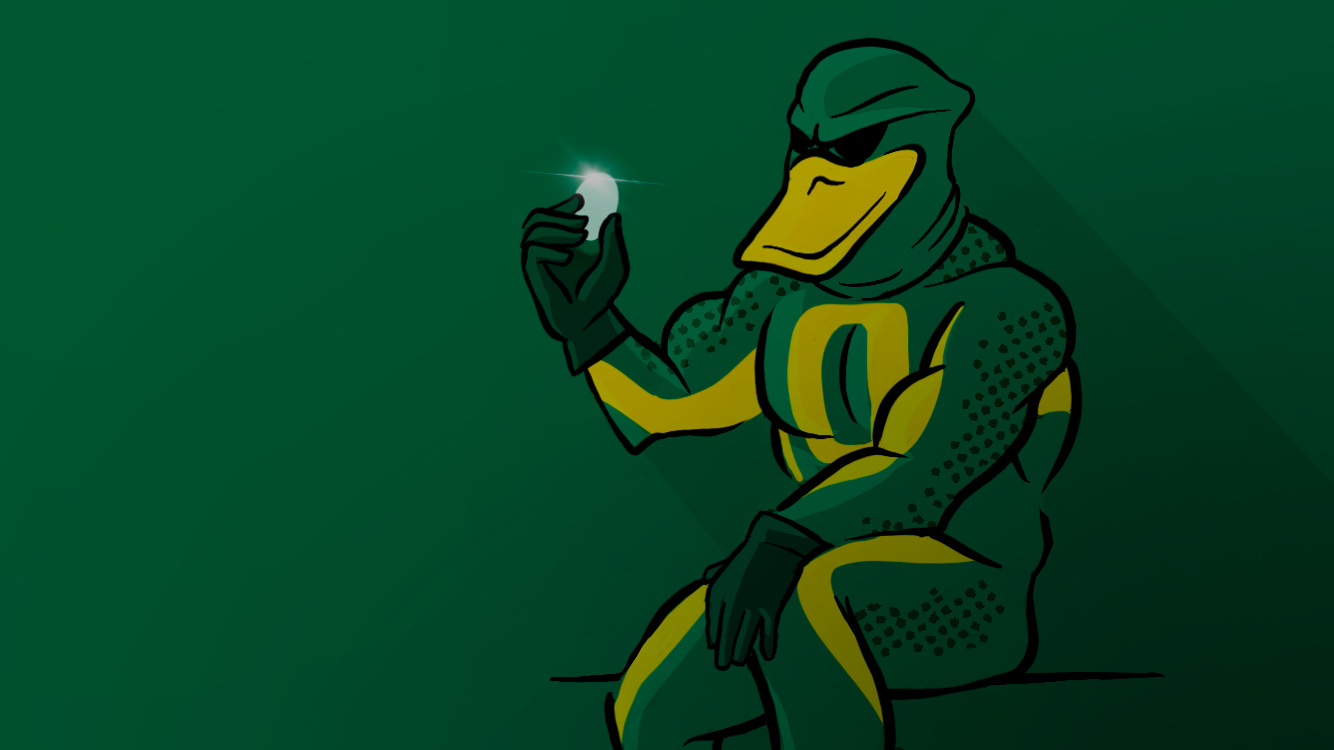
Consider this your Ditch Rich Holiday Special. Thanks for all your support this year, and here’s to a brighter 2021. Go Ducks.
Our story begins in Dallas, Texas, 1996—right after the Ducks got absolutely hosed by Rick Neuheisel’s Colorado Buffaloes in the Cotton Bowl. Nike co-founder and UO alum, Phil Knight, had a post-game heart-to-heart with UO Head Coach Mike Bellotti, and asked him something along the lines of: “What do you need?”
Long before Eugene became the epicenter of college football’s uniform boom, and even longer before Oregon would ever step on to the field to compete for a National Title, the humble Ducks lived their life on the outskirts of the Pacific-[8-10-12] Conference. But Buck Knight had clearly seen just about enough of that mediocrity.
What followed that Knight/Bellotti conversation has been well-documented by Duck fans and detractors alike, but let’s just say that Uncle Phil has come through with just a tiny bit of donation money to the University of Oregon over the years—both inside and outside of the classroom.
When Phil Knight became more involved at Oregon, he brought the creative brain power of Nike along with him. Between Nike’s trademark “innovation,” and the school’s willingness to try almost anything to become relevant, Eugene became the jumping off point for the Swoosh to change the look of college football forever.
Oregon’s new uniforms took the nation by surprise immediately.
Famous Jordan shoe designer (and former UO Pole Vaulter) Tinker Hatfield created the now iconic “O” logo, then Uncle Phil threw in a bit more money for the rain-escaping indoor practice facility—along with a $90 Million, 13,000 seat expansion of Autzen Stadium*.
*An embattled process in it’s own right that WILL get the Ditch Rich treatment soon enough.
The modern style attracted bigger recruits. The resources helped them perform at a higher level. And it was only a matter of time before Oregon Football would find itself right near the top of the college football landscape for the first time in program history.
From finishing second overall in the final 2001 AP & Coaches’ Polls (their highest ever); to the influx of Nike money that ushered in the NCAA facilities arms race; to Joey Harrington’s face plastered on everything from NYC billboards to the cover of EA Sports’ NCAA; the Ducks were quickly becoming the hot new program for a new millenium.
But the sleek, innovative, “Oregon Brand” did not grow into what it is now without a couple of hiccups along the way.
With the benefit of hindsight, we now know that unveiling flashy new uniforms is a tricky thing in the social media era, but you can thank the Ducks for basically running the first dozen case studies on the subject.
Reuben Droughns-era Oregon teams shocked the nation with now-classic green and yellow uniforms that just-so-happened to feature a small Nike swoosh right along the collarbone.
“Gasp! Corporations are invading amateurism!”
Nike’s innovation—coupled with Oregon’s on-field success—is undoubtedly the reason that the Ducks have grown into the national brand that they are today. And most Duck fans are quite proud of nearly all the things that Uncle Phil has helped create for their athletics, and their university as a whole.
Alas, for every fan-favorite uniform combination, there are always other creations that don’t get quite as much love.
Enter: RoboDuck.
An action-figure/superhero/future Rule 34 victim that was quite literally hatched by the brain trusts of the University of Oregon Athletic Department and creative leads at Nike.
During halftime of a 2002 football game in Eugene, the one true Oregon mascot—The Duck—wheeled a giant egg out onto the field with much fanfare and anticipation. There was entrance music, there was a smoke machine, and there was even some soft applause when RoboDuck (AKA Mandrake) emerged from his shell, six-pack abs and all.
According to his creators, he wasn’t ever meant to replace “The Duck” as the permanent mascot at the U of O. He was instead created to serve as a more flexible representation of the University, in multiple senses of the word.
For the uninitiated, the Oregon Duck mascot has had a long history of ownership, copyright, and a lack of basic freedom.
In the 1920s, Oregon students would actually bring a live duck named Puddles to watch the Webfoots play. Believe it or not—even in “another time”—the people of Eugene didn't think that was such a swell idea.
Puddles was retired, but deep into the 1940s, UO student publications would feature illustrations of a duck that bore a striking resemblance to another famous mallard named Donald.
Walt Disney himself took notice of this blatant intellectual property theft, but Oregon Athletic Director Leo Harris managed to connect directly with Walt, and settled on a handshake agreement that allowed the school to use Donald’s likeness for good.
Making a deal with The Walt Disney Company, however, apparently isn’t always that simple.
A few years after Disney’s death, lawyers circled back to challenge the so-called agreement, and the University produced a photo that featured Leo Harris and Walt both wearing Oregon lettermen jackets. The picture also featured the one and only Puddles the Duck.
So in 1973, Disney agreed to honor Walt’s wishes, so long as the UO could, “ensure that the performer in the costume had the ability to properly represent the Donald Duck character,” and the agreement also directed, “where and when the costume could be used: generally at UO sporting events, or at fundraisers that Disney has approved of in writing in advance.”
“Double gasp! Corporations are becoming a controlling force in amateurism!”
Gamers may remember that the NCAA Football games curiously never featured The Duck as a playable character in mascot mode. Disney’s helicopter-parenting of their IP made licensing and rights deals a nightmare, and originally restricted The Duck from spreading his wings across pop culture.
But as Oregon was ascending the ladder of their own brand growth in the 2010s, they grew tired—like many of us do—of being beholden to every one of Mickey Mouse’s capitalistic whims.
So they decided to just make a new mascot.
A symbol that could theoretically dominate mascot modes, appear in commercials, and shill for local used car dealerships (or, in the case of today’s Duck, Rocket Mortgage ads).
And in 2002, the bright-eyed RoboDuck—introduced with so much enthusiasm and marketing money—absolutely had a chance, if only for a brief moment, to become a valuable new icon for the University.
But then, the villagers turned on him.
Whether it was a fear of RoboDuck competing with their beloved Duck, or a confusion about what Nike was warping the program into, Oregon fans and the national media revolted against RoboDuck almost immediately after his birth.
I cannot even fathom what RoboDuck’s introduction would have been like in today’s era of memes and Twitter bots.
After facing constant ridicule from the very people he was meant to please, RoboDuck disappeared in shame by 2003—not even a year old.
To this day, many Duck fans can be easily moved to anger just at the mention of his name. But I think that any animosity aimed at the high-flying mascot himself is tragic.
I’ll admit, the mascot suit itself, and the idea that a whole new character could garner fan favor in the same way that slick new uniforms do, was pretty stupid. It was something that definitely should have been shot down in an early creative meeting.
I’m not calling for a return of RoboDuck by any means.
But Nike innovation unquestionably helped build the U of O into the athletics program it is today. The creative, outside-the-box thinking that designed the iconic “O”, or thought to put chrome helmets out onto the field, was the very same creative thinking that also gave birth to RoboDuck.
You have to take the good with the bad, and obviously even Nike misses sometimes.
Mad with power, and unburdened by the question of whether or not they should, Nike and the U of O engineered a misunderstood monster and let him loose into a world that wasn’t quite ready for him. Still unsure of their status as, “Swoosh University.”
And so, RoboDuck was brutally cast aside, only to watch his older brother finally break the chains of Disney copyright, and take the world by storm—one push-up at a time.
Oregon reached a new agreement with Disney in 2010 (right about when Lee Corso and College Gameday started featuring the Duck a little more) that separated The Duck and Donald Duck even more.
A new “Fighting Duck” logo was developed (by Nike), to be used more freely on all sorts of sellable goods. But to this day, every piece of Oregon merch that features an original graphic Donald still must include an adorable little, “Copyright Disney,” right beside it.
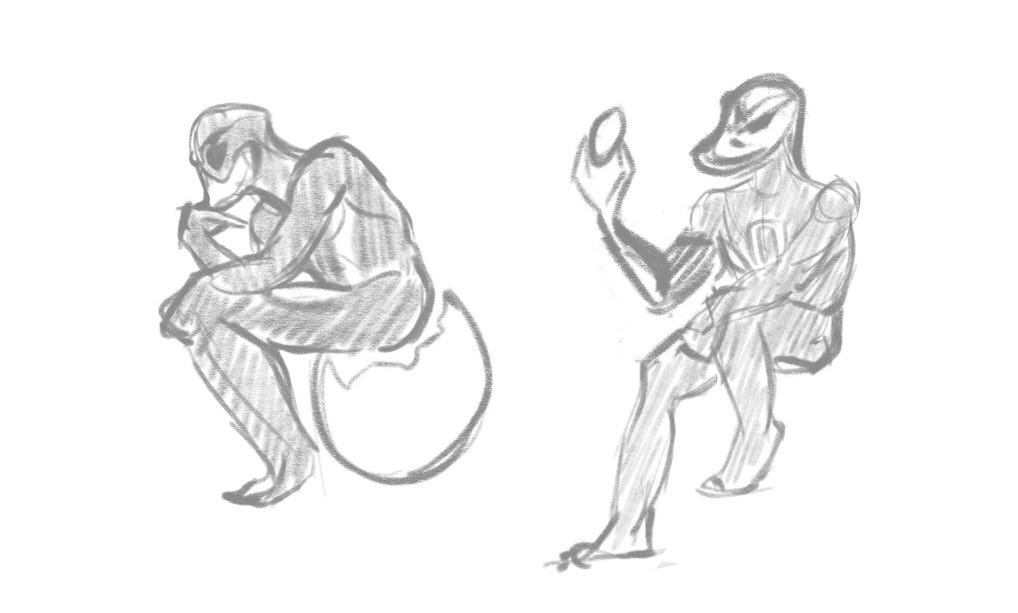
RoboDuck’s tragedy is about the corruption of the natural order. And like most Promethean tales, when played out in real life, RoboDuck has much more in common with Mary Shelley’s Frankenstein, than he does with Percy Shelley’s romantic, Prometheus Unbound.
Since the death of RoboDuck, Nike has continued to work closely with Oregon, as well as so many other college football programs.
Some of their new ideas have worked swimmingly (see: the introduction of the Jumpman logo to the gridiron), and some of them not-so-much (see: Oregon’s piss green flame helmets from the 2006 Las Vegas Bowl), but one thing is for sure, they will never stop throwing stuff at the wall and seeing if it sticks.
And they do not care how many super-buff, anthropomorphic crossfit-gymnast mallards are harmed in the process.
So, the next time you ponder about the impact of corporations on college athletics—whether it’s a legacy brand like Disney, or an innovator like Nike—please, consider the RoboDuck.
Go Ducks.
This piece was written by myself, James Vos, with editing support from Matt Brown, creator my favorite newsletter, Extra Points.





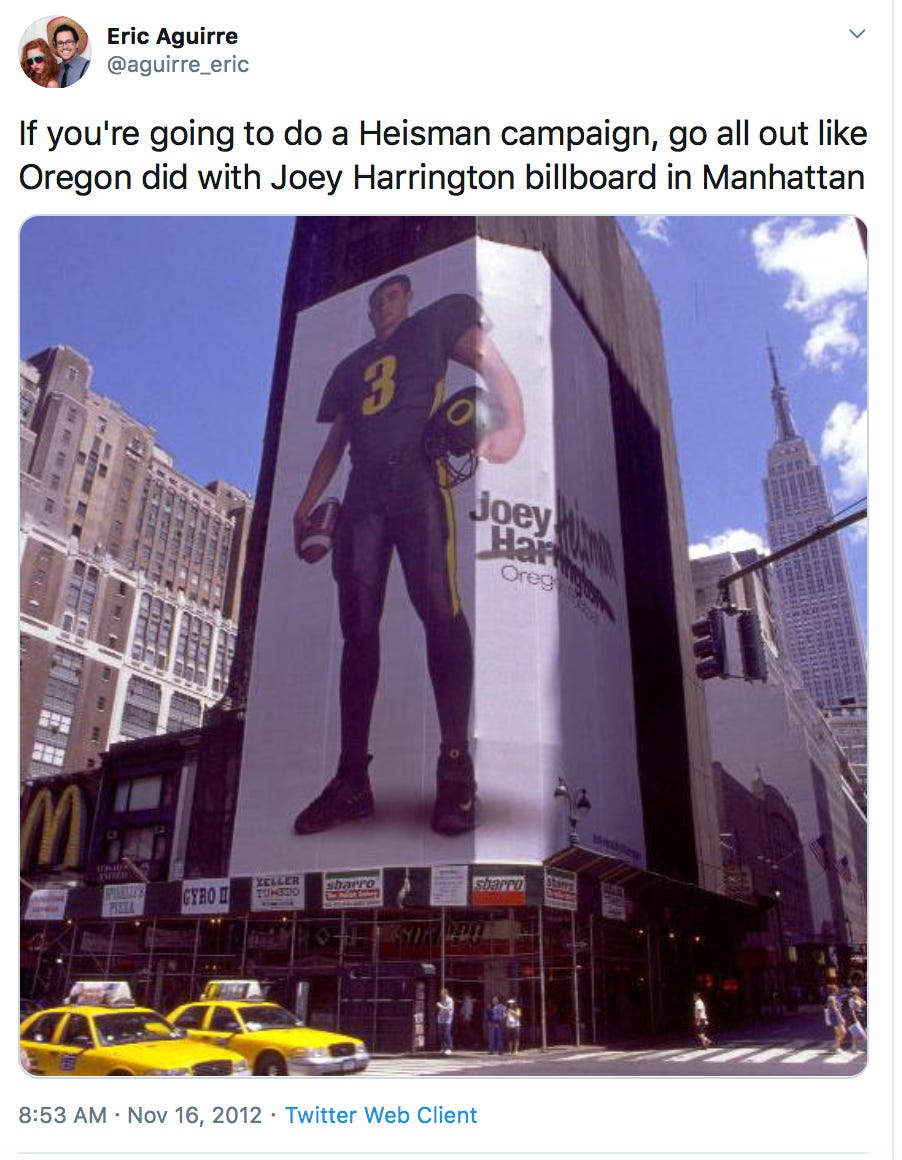
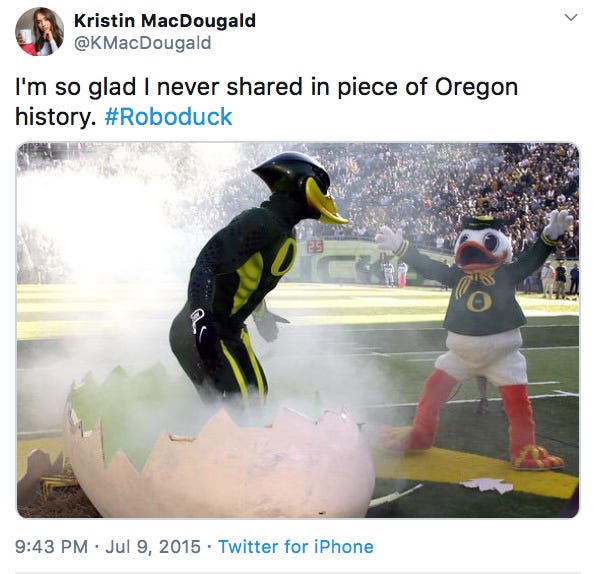
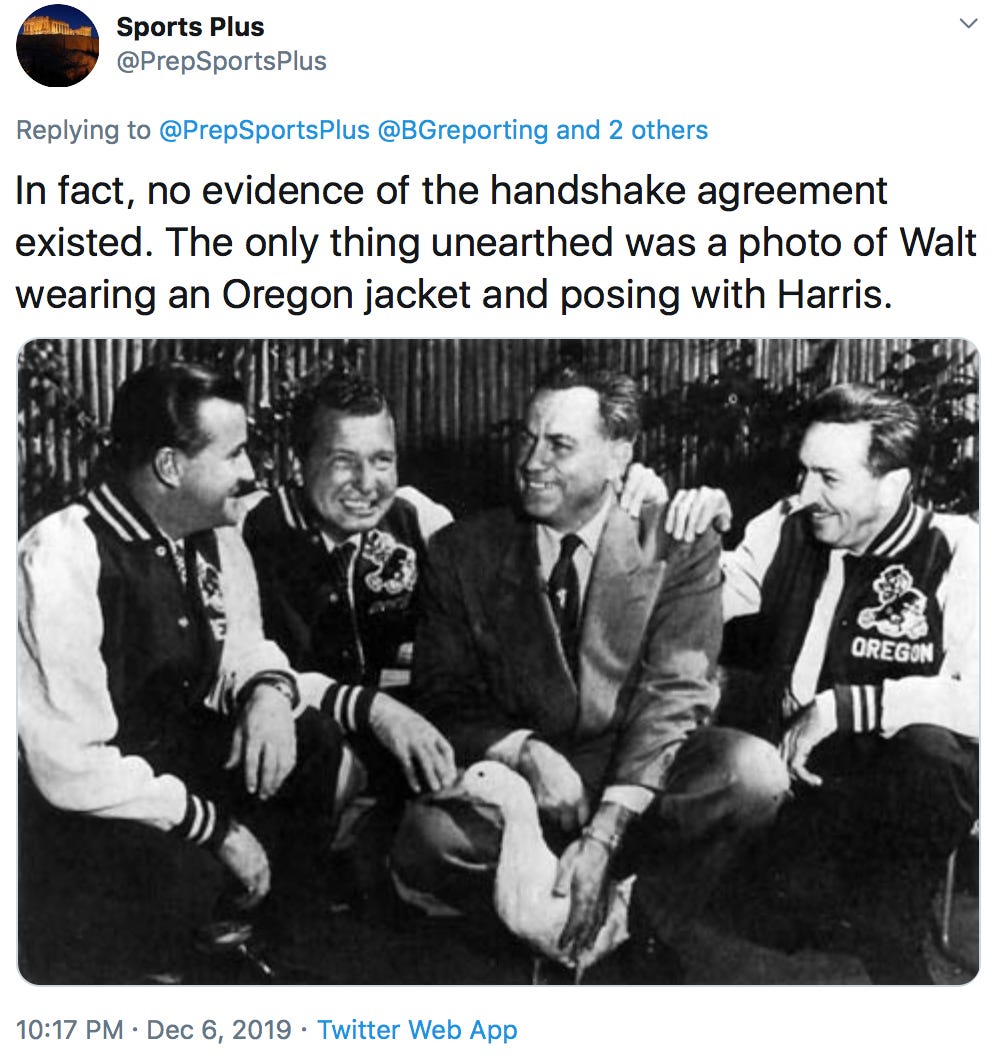
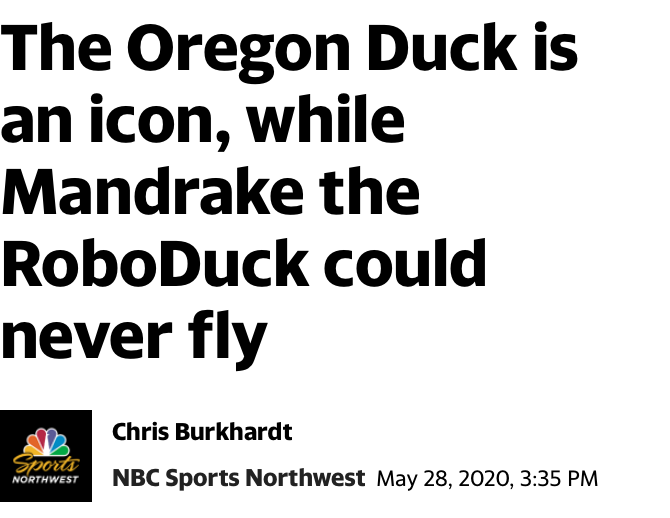
Love the picture!
Anthropormorphically impressed